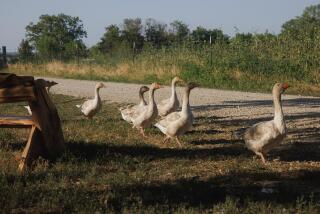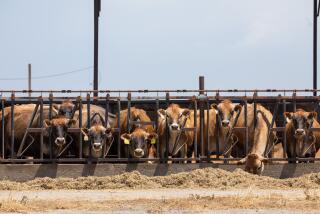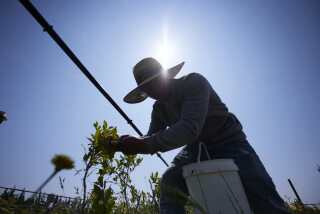New Zealand aims for greener pastures
WELLINGTON, NEW ZEALAND — Over thousands of years of evolution, sheep, cattle and other cud chewers developed a nasty habit. They burp and break wind a lot.
That gives New Zealand a distressing gas problem.
The country’s 4 million people share two islands in the South Pacific with 40 million sheep, 9 million beef and dairy cattle and more than a million farmed deer, all producing the methane that many climate scientists say is one of the worst culprits behind global warming.
It may be a small country on the edge of the world, but New Zealand has big ambitions in the fight against climate change. Last year, Prime Minister Helen Clark set a national goal of becoming the world’s first carbon-neutral country.
Livestock farmers, long among the country’s major export earners, are worried. They say the cost of fighting greenhouse gases could drive many of them into bankruptcy, and they feel they’re being singled out because New Zealand has relatively few big industrial polluters.
“There’s no other country in the world that’s so clean of chimney stacks that its animals are the biggest polluters,” said farmer Charlie Pedersen. “It’s kind of an ironic situation.”
He owns an organic farm with 9,000 head of cattle and sheep in the seaside community of Foxton, 60 miles northeast of Wellington, New Zealand’s capital. It’s a quiet place of wind-swept sand dunes and an authentic Dutch windmill that’s easily missed sitting next to Highway 1, the two-lane road linking Wellington with New Zealand’s biggest city, Auckland.
But as president of the Federated Farmers of New Zealand, Pedersen speaks for the owners of 14,000 farms, roughly two-thirds of the country’s total, and his voice carries into the corridors of power.
Five years ago, farmers revolted to defeat a plan to levy a tax on each head of cattle, sheep, goat and deer to fund research on controlling their gas emissions. The anger is building again, this time against a proposal to make the farmers the world’s first forced to pay if they exceed government-imposed limits on greenhouse gases.
If it goes ahead, the plan could slash New Zealand farmers’ profits by half over the next five years, driving big exporters out of business in the middle of a global food crisis, Pedersen warned.
“We’re going to put our system under those costs with no opportunity to get any more from the market for our food,” he said. “The consumer tends to be -- I’ll reluctantly say this -- a little bit of a hypocrite.
“They want food to have all sorts of fine attributes as far as animal welfare, and to be as sustainable as possible with minimal or no effect on the environment in which it’s produced. But they also rely on the supermarket to bid the price down as much as possible, and give the food producer as little return as possible.”
Livestock produce an estimated 20% of the world’s methane output, which also comes from landfill sites, coal mining, rice paddies and other sources. Methane and the even more potent nitrous oxide make up about half the greenhouse gases that New Zealand adds to Earth’s air.
Most of it rises from bucolic pastures where the country’s iconic sheep and cattle graze, chewing, regurgitating and chewing again, and pumping out methane -- the bulk of it in their belches.
A team of New Zealand scientists, backed by millions of dollars from the farm industry and the government, are conducting world-leading research into possible solutions, including genetic engineering, cloning and a vaccine for gassy animals.
“Given that we’re trying to turn around hundreds of thousands of years of evolution, it’s no small challenge,” said Mark Aspin, manager of the Pastoral Greenhouse Gas Research Consortium, which is jointly funded by the farming industry and the government.
As the world debates how to limit suspected man-made causes of climate change, carbon dioxide is getting most of the attention. It’s the most abundant greenhouse gas, spewed from vehicle exhaust, coal-fired power plants and other industrial sources.
But methane and nitrous oxide, which is produced as bacteria feed on grazing animals’ dung and urine, come in a significant second. Methane is about 23 times more powerful by weight in warming the atmosphere than is carbon dioxide, and nitrous oxide is 310 times more potent.
Together, they make up almost a third of greenhouse gases contributed by human activities since preindustrial times, according to the Intergovernmental Panel on Climate Change, the scientific body set up the by the United Nations to provide information on global warming.
If the 25 full-time researchers in Aspin’s labs discover the secret to making livestock less belchy and flatulent, they could help make billions of farm animals around the world more environmentally friendly.
Cud-chewing farm animals produce a lot of methane because their food passes through a first stomach, called the rumen, where it ferments in a soup of saliva, bacteria and other microbes. Those bugs break down the food for digestion.
New Zealand researchers are looking for ways to inhibit or eliminate a group of microbes called methanogens, which transform rumen gases into methane. They’re also studying the animals’ diet to see whether low-fiber, high-sugar substitutes will help the climate.
Farm animals fed plants higher in tannin produce less methane, but such food costs more.
Some scientists have seen promise in feed additives, such as a kind of yeast or garlic, which doesn’t help animals grazing in pastures much.
Breeding may hold the solution, because not all sheep and cattle are created equal. Some are high methane emitters, others low. If that’s an inheritable trait, then genetic engineering could rid the world of gassy livestock.
Aspin’s researchers are under new pressure to find the answers. Clark’s government is the world’s first to propose that farmers be included in a plan that encourages greenhouse gas reductions by setting emission limits and forcing producers to buy credits on the open market if they exceed them.
Farmers could go bankrupt buying carbon credits so their livestock can keep doing what comes naturally, Pedersen warned.
In the fight against global warming, farmers are unarmed, and it’s up to scientists to give them the weapons they need, Aspin said.
“There’s a very strong ethos in New Zealand farmers,” he added. “They do feel like they are stewards of the land. We’re only here for a short time, so we have to leave it in a better state than we found it.”
--
More to Read
Sign up for Essential California
The most important California stories and recommendations in your inbox every morning.
You may occasionally receive promotional content from the Los Angeles Times.










